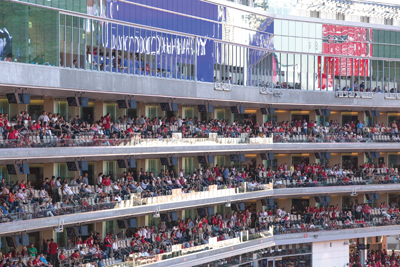The NFL is projecting revenue of more than $12 billion for this year, a roughly $1 billion increase over 2014, fueled by TV money and better-than-expected local revenue.
The figures underscore that despite the persistent off-field crises for the league during the 2014 season and calls for Commissioner Roger Goodell to resign, the NFL’s business remains robust.
A solid share of the projected increase is attributed to media. DirecTV renewed its NFL contract last year, and 2015 is the second year of the league’s new TV pacts with ESPN and its network partners as well, deals that contain accelerators to increase payments annually.
Those details, however, were known in December, when the league projected a salary cap for 2015 of between $138.6 million and $141.8 million.
The 2015 salary cap that was officially announced last week is $143.28 million.
What changed between December and now, besides a $25 million bump in CBS’s Thursday night TV package, was higher-than-expected local revenue. When the NFL salary cap is set, the local-revenue calculation is pegged to the preceding year’s financial results. Between December (when the NFL makes its first projection to owners) and the beginning of the league year in March (when the cap is set), teams update their 2014 totals.
Dating to the 2008 financial crisis, local revenue for the NFL — which accounts for less than half of all league revenue — had become relatively sluggish. In response, the league in recent years has invested aggressively in the in-venue experience, and that effort now appears to be paying some dividends.
Last season, for example, there were no local TV blackouts of games because all 256 games were classified as sellouts, continuing a recent trend of a declining number of blackouts annually. There were 22 blackouts in 2009 and 26 in 2010, but by 2013 there were only two and none last year.
 |
Levi’s Stadium provided a big increase in premium-seat revenue for the 49ers, and pushed league revenue numbers up.
Photo by: VICKI THOMPSON / SILICON VALLEY BUSINESS JOURNAL
|
“You are seeing NFL teams much more add specialty seat products, some all-inclusive tickets, amenities like on-field access, and that is beginning to have a real impact,” said Mark Lamping, president of the Jacksonville Jaguars, whose team’s local revenue surged 25 percent last season.
The addition of the new Levi’s Stadium, which opened last fall, also fueled the league’s overall increase from the team level. The San Francisco 49ers went from zero club seats to 9,000, said 49ers President Paraag Marathe. The team also had 73 usable suites at its old home. By comparison, it has nearly 100 more than that at Levi’s Stadium.
Teams are starting to cash in on digital as well, Lamping said, as companies are spending more advertising in that space.
The NFL declined to confirm or deny the projected figure of more than $12 billion in revenue for 2015, but it did not dispute the math that SportsBusiness Journal used to arrive at the number.
The collective-bargaining agreement mandates players receive between 47 percent and 48 percent of what the labor pact terms “all revenues,” which includes most league cash inflows, such as national and local media, sponsorship dollars, tickets and concessions.
The players’ take is divided between salary ($143.28 million cap figure) and benefits, which are $37.55 million per club in 2015, resulting in a per franchise labor cost of $180.83 million for 2015. If players were to receive the higher, 48 percent amount of “all revenues,” that would translate to an average club revenue total of $376 million; multiplied by 32 teams, the result is $12.055 billion in revenue leaguewide. Using the lower, 47 percent amount for the players, the resulting “all revenues” figure comes to $12.31 billion.
But that is not the end of the NFL’s revenue calculation. Some revenue the CBA allows the league not to share with the players. Examples include money invested in concessions equipment, ticket surcharges, nonroyalty revenue from the Dallas Cowboys’ merchandise arm and the value of some complimentary tickets. In other words, the total revenue of the NFL would be somewhat higher than the calculated “all revenues” range of $12.055 billion to $12.31 billion.
Last year, the NFL posted $11.2 billion for its “all revenues” sum, a football source said.
Five years ago, Goodell challenged the owners at a league meeting to increase revenue to $25 billion by 2027. At the time, the league’s revenue was $8.5 billion, so the NFL will have grown 41 percent since the time Goodell made that challenge as it proceeds to the projected 2015 sum. The projected growth for 2015 also is the most significant annual gain since the commissioner laid down that goal.
The NFL on average needs to add $1 billion annually for the next 13 years to achieve Goodell’s vision. At his annual press conference in January before the Super Bowl, Goodell did not guarantee success but he stood by the mark.
“I don’t know whether we’ll get there, but we’re working towards that goal,” he said. “It’s something that we think is practical.”
The addition of new stadiums in Atlanta and Minnesota in coming years will help further, as would getting a team, or teams, into Los Angeles. The league’s broadcast contracts are up for renewal at least once before 2027, and the league is still exploring whether to stream games on tablets and computers.
The NFL remains the top revenue league in U.S. sports. MLB registers about $9 billion annually, the NBA $5 billion and the NHL $3.6 billion.




